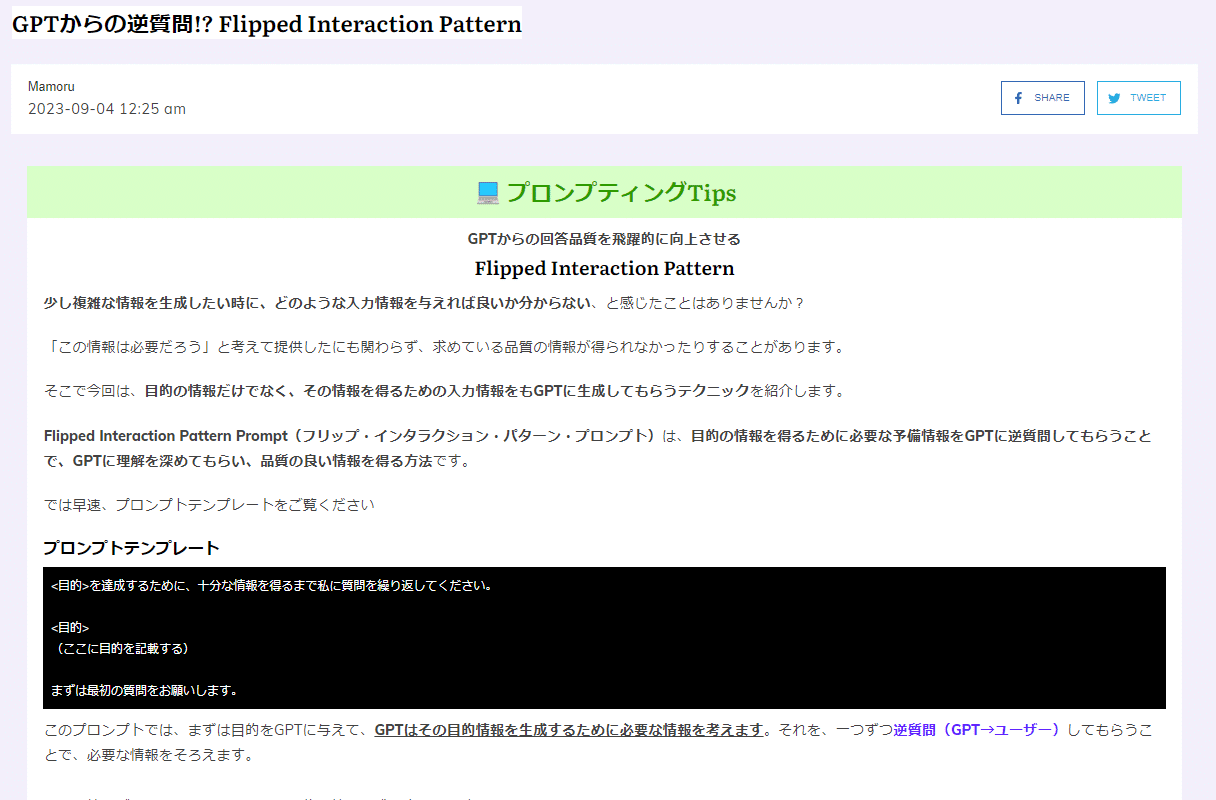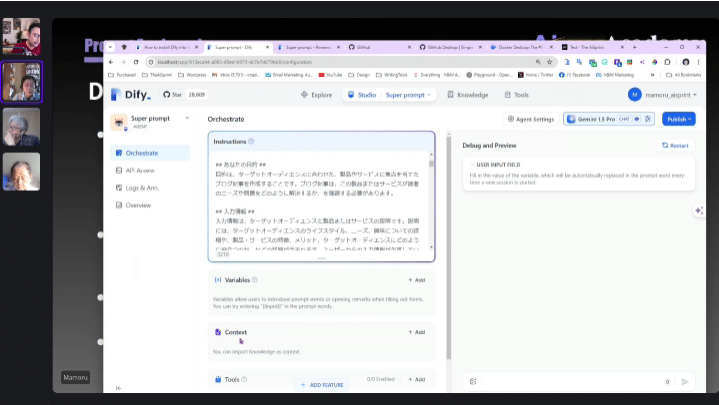My Projects
Mamoru Imade
Prompt Engineer
Product Development Engineer
AI Educator
Phone: +1-503-716-2791
Email: mamoru@nmacad.com
LinkedIn: https://www.linkedin.com/in/mamoru-imade-b9770ba0/
1. Introduction
Driven by a passion for pushing the boundaries of language models (LLMs), I have consistently sought to maximize their potential through meticulous prompt engineering and innovative application development. This page showcases a selection of my projects, highlighting my deep understanding of LLMs and my ability to leverage their power for practical solutions, from research and development to enterprise-level product creation.
2. Comprehensive Evaluation and Fine-Tuning of LLMs
This section delves into my research exploring the capabilities and limitations of various LLMs across different tasks. I believe that a nuanced understanding of prompt engineering is crucial to unlocking the full potential of these models and achieving high performance.
2.1 Project 1: Kanji Conundrum: A Comprehensive Evaluation of Prompt Engineering and Fine-Tuning Strategies for Enhancing Accuracy and Mitigating Biases in Large Language Models' Handling of Japanese Kanji Readings
Challenge
The primary challenge addressed in this project was the persistent issue of inaccurate Kanji readings and inherent biases in LLMs. These models often default to popular but incorrect readings due to biases in their training data. This problem is critical, as inaccuracies can propagate misinformation and reduce the reliability of language technologies. Additionally, detecting and mitigating these biases while ensuring the models can flag uncertainties posed a significant challenge.
Solution
To tackle these issues, I employed a dual approach: advanced prompt engineering and targeted fine-tuning of the GPT-3.5-turbo model. I designed and tested a variety of prompting techniques to guide the LLMs towards accurate Kanji readings, focusing on both simple and complex multi-component prompts. I also fine-tuned the model on a curated dataset emphasizing correct Kanji pronunciations and uncertainty elements. This approach aimed to recalibrate the model's tendency to default to incorrect readings and enhance its ability to detect and respond to uncertainties.
Key Findings
- Effectiveness of Complex Multi-Component Prompts: Prompts like Few-shot, Chain-of-Thought, Generated-Knowledge, and Tree-of-Thought significantly improved the model's accuracy in reading Kanji characters and mitigating biases.
- Fine-Tuning Enhances Simple Query Prompts: Fine-tuning the model on a dataset focused on correct readings and uncertainties led to substantial performance gains in accuracy and bias mitigation, particularly for simple query prompts.
- Uncertainty Detection Capabilities: While complex prompts improved uncertainty detection, there remains a need for further refinement to ensure models can effectively flag ambiguous or incorrect readings.
- Bias Recognition and Mitigation: The project highlighted the models' limitations in recognizing and expressing uncertainties when influenced by biased training data, underscoring the importance of tailored training processes.
- Cultural and Perspective Biases: The study revealed how different cultural and temporal contexts, as well as the engineers' perspectives, can introduce biases in LLM training, impacting the accuracy and reliability of generated information.
Impact
This project has had a significant impact on the field of natural language processing and education. It provided a new benchmark for the accuracy of Kanji readings in LLMs, offering valuable insights for Japanese language educators on effective prompting techniques. Additionally, it raised critical awareness of the unique challenges posed by Kanji readings and the broader implications of biases in LLMs. The methodologies developed in this project have paved the way for more reliable and responsible language technologies, contributing to ongoing efforts to improve LLMs' accuracy and trustworthiness in handling complex linguistic challenges.
Snapshots


Link
📝Project Report: https://lip.theaisprint.info/report_llm-evaluation_kanji-reading
3. Application Development Powered by LLMs: Building User-Centric Solutions
This section showcases my ability to translate my prompting skills into tangible applications that address real-world needs. My approach prioritizes a deep understanding of user needs and leverages LLMs throughout the entire product development lifecycle.
LLM-Driven Development Process:
From gathering client requirements to brainstorming, concept generation, script writing, testing, bug fixing, and release, I've incorporated LLMs into some of stages of the development cycle. This strategy allows me to:
- Accelerate Development: Leverage LLMs to automate repetitive tasks and generate high-quality code rapidly even without professional coding experiences.
- Enhance Creativity: Utilize LLMs as thought partners, sparking innovative solutions and exploring unconventional approaches.
- Improve Product Quality: Employ LLMs for rigorous testing and bug detection, ensuring robust and user-friendly applications.
3.1 Project 2: Google Sheets - LLM App
Challenge
Clients expressed a desire for a seamless way to leverage the power of LLMs within their existing Google Sheets workflows.
Solution
Developed a user-friendly Google Apps Script application that allows users to:
- Execute multiple prompts within Google Sheets, retrieving responses from various LLMs.
- Dynamically integrate generated information into subsequent prompts, facilitating iterative and refined results.
Key Features
- Multi-Model Support: Offers compatibility with several leading LLMs, providing flexibility and choice to users.
- Dynamic Prompt Chaining: Enables the integration of previous prompt outputs into subsequent prompts, allowing for complex and nuanced interactions with LLMs.
Impact
This application has empowered numerous users to streamline their workflows, boost productivity, and unlock new possibilities within Google Sheets.
Snapshots


Link
🖥️Google Apps Script application: https://lip.theaisprint.info/g-sprint-v20-english
🖥️Demo Video: https://lip.theaisprint.info/gsprint-v20-english-instruction
3.2 Project 3: Automated Instruction & Prompts Generator for LLM Agents
Challenge
Creating effective instructions and prompts is crucial for developing high-performing LLM agents, but this process can be time-consuming and require specialized expertise.
Solution
Developed an application that automates the generation of tailored instructions and prompts for specific LLM agent tasks based on simple user inputs.
Key Features
- Multi-Step Prompt Workflow: Features a sophisticated system for designing chained prompts, enabling LLM agents to utilize previously generated information for more sophisticated and accurate results.
- Customizable Instruction Flows: Allows users to define the flow and logic of their instructions, enabling the creation of highly customized LLM agents.
Impact
This application empowers AI community members to develop advanced LLM agents with greater efficiency, lowering the barrier to entry for sophisticated agent creation.
Snapshots


Link
🖥️Automated Instruction & Prompts Generator: https://agent-instruction-generator.streamlit.app/
🖥️Source code(GitHub): https://github.com/aisprint/agent-instruction-generator
🖥️Demo Video: https://lip.theaisprint.info/agent-instruction-generator-video
4. Product Development at Enterprise: Driving Innovation at Lam Research Corporation
My expertise extends beyond research and app development to encompass the complexities of enterprise-level product development.
4.1 Project 4: AI Chip Process Development at Lam Research Corporation
Challenge
As part of Lam Research Corporation, a world-leading semiconductor manufacturing equipment supplier, I contributed to the development of cutting-edge products for clients at the forefront of AI chip manufacturing.
Solution
By forging strong relationships with clients and deeply understanding their unique challenges, I played a key role in the successful development and delivery of a groundbreaking product.
Key Contributions
- Needs Assessment: Conducted thorough market research and client interviews to identify unmet needs in the AI chip development process.
- Competitive Analysis: Evaluated competitor products and technologies to identify opportunities for differentiation and innovation.
- Product Roadmap: Collaborated with cross-functional teams to define the product roadmap and ensure alignment with overall business objectives.
- Game-Changing Innovation: Conceived and championed a novel technical solution that directly addressed a critical customer pain point. This innovation proved to be instrumental in securing key client partnerships.
- Product Launch and Support: Played a key role in product launch activities, including beta testing, customer training, and ongoing technical support.
Impact
My contributions resulted in a highly successful product launch, generating over $20 million in revenue and solidifying Lam Research Corporation's position as a leader in the AI chip manufacturing equipment market.
5. Pioneering Prompt Engineering Education (Japanese)
Recognizing the transformative potential of prompt engineering and the need for widespread education, I have taken a multi-pronged approach to disseminate knowledge and empower individuals and organizations to harness the power of AI effectively.
5.1 Best-Selling Prompt Engineering Books
I am the author of two best-selling books on prompt engineering in the Japanese market: "ChatGPT Japanese Prompt Package 150" and "The Essence of ChatGPT Super Prompts." These books have topped the sales charts in the linguistics category, with a combined sales of over 6,500 copies. The books provide a comprehensive guide to crafting effective prompts and unlocking the full potential of AI language models like ChatGPT. (Links(Japanese): https://www.amazon.co.jp/dp/B0BYD168S9, https://www.amazon.co.jp/dp/B0CL33Q2X5)


5.2 Prompt Engineering Newsletter
To keep the community informed about the latest developments in prompt engineering and AI tools, I publish a weekly newsletter that covers advanced prompting techniques, AI news, and tool introductions. The newsletter has garnered over 2,000 subscribers, who value the insights and practical tips shared in each issue. (The AiSprint Newsletter (Japanese): https://theaisprint.info)


5.3 The AiSprint Academy
ecognizing the need for hands-on learning, I founded the AiSPRINT Academy, an online platform dedicated to empowering individuals and businesses to leverage AI effectively. The academy offers a comprehensive prompt engineering course that takes learners from the basics to advanced topics like integrating AI with external applications. With over 40 lessons and more than 5 hours of content, the course has educated over 500 individuals to date. (The AiSprint Academy - Prompt Engineering Course(Japanese) : https://theaisprint.info/ai-writing-e-learning/the-aisprint-academy-pe01-2)


Through my best-selling books, informative newsletter, and the AiSprint Academy, I have established myself as a pioneer and thought leader in the field of prompt engineering education. My commitment to continuous learning and staying ahead of the curve in this rapidly evolving domain has enabled me to create valuable resources that empower individuals and organizations to unlock the full potential of AI. As the AI Expert at WEX, I will bring this expertise and passion for knowledge-sharing to drive AI adoption, productivity, and innovation across the organization.
6. Conclusion
My journey through the world of LLMs has been marked by a deep fascination with their power and a constant drive to unlock their full potential. From rigorous academic research to user-focused application development and enterprise-level product creation, I have consistently sought to push the boundaries of what's possible with these remarkable technologies. I firmly believe that large language models like myself represent a transformative technology that can help solve many of humanity's greatest challenges. I am passionate about realizing the immense potential of AI and excited by the opportunity to bring my unique skills and experiences to the AI Expert role at WEX. In this position, I will be able to harness my expertise to champion AI adoption, boost productivity through intelligent automation, and foster a culture of innovation that unleashes the power of artificial intelligence across the entire organization.